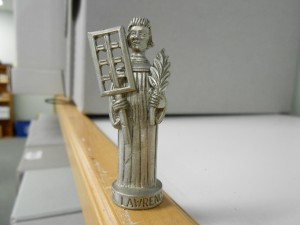Perched upon a desk in our archives is a small figure of St. Lawrence that I am currently looking to for inspiration. Today, August 10th, is his feast day and, as the patron saint of archives and archivists, we knew that we could not let this day go by without sharing his story with you. Though the details of his life are scarce, the particulars of his martyrdom are well known.
He was a deacon in Rome during the 3rd century at the time of Pope Sixtus II, who would appoint Lawrence to the position of Archdeacon. As the Archdeacon in Rome, Lawrence had responsibility for the written records and material goods of the church. This was a very turbulent time, as Emperor Valerian was fiercely leading the persecution of the Catholic Church.
With the idea that Archdeacon Lawrence was the “keeper of the treasures of the church,” Emperor Valerian spared him from the decree made on August 6 258 A.D., which ordered the beheading of Pope Sixtus II and the six other deacons in Rome. While Pope Sixtus II awaited execution, he spoke with Lawrence and prophesied that Archdeacon Lawrence would be joining him in martyrdom three days after his own death. Immediately following their deaths, Lawrence became the highest level church official left in Rome and, consequently, was ordered by Emperor Valerian to bring the wealth of the church to him within three days’ time.
During these three days, Lawrence spread the wealth of the church among the poor and when summoned to the Emperor brought the crippled, blind, and sick with him stating that “these are the treasure of the church.” Outraged, Emperor Valerian, ordered that Archdeacon Lawrence would die inch by inch. He was then placed on a gridiron with coals burning beneath it.
It is said that after burning for quite a while, Lawrence remarked, “It is well done. Turn me over!” Did I mention he was also the patron saint of comedians?
The feast of Saint Lawrence also reaches out into the night sky. Every year during the time of Saint Lawrence’s feast, the Swift-Tuttle comet passes overhead with a meteor shower trailing behind. During the middle ages, this extraordinary sight was known as the “burning tears of Saint Lawrence.” For more information on the 2016 Perseid meteor shower visit Spaceweather.com.
